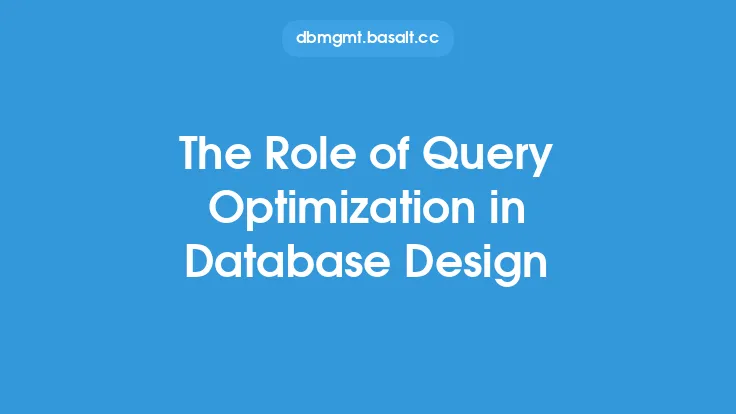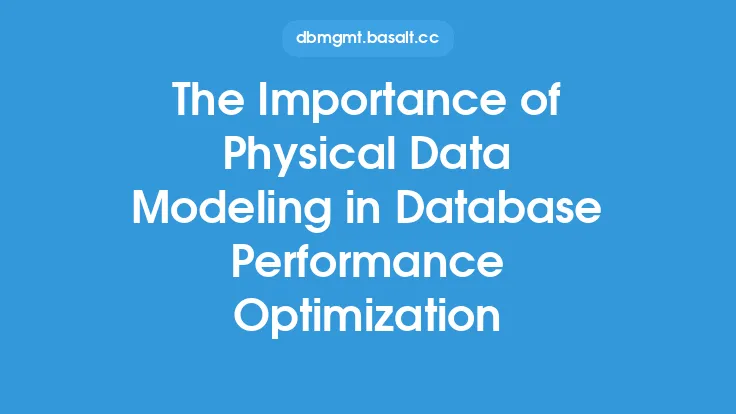Database query optimization is a crucial aspect of ensuring the performance and scalability of databases. One of the key techniques used to optimize database queries is indexing. Indexing involves creating a data structure that improves the speed of data retrieval operations by providing a quick way to locate specific data. In this article, we will delve into the importance of indexing in database query optimization and explore how it can be used to improve the performance of databases.
Introduction to Indexing
Indexing is a technique used to speed up the retrieval of data from a database by creating a data structure that facilitates quick location of specific data. An index is a data structure that contains a copy of selected columns from a table, along with a pointer to the location of the corresponding rows in the table. Indexes can be created on one or more columns of a table, and they can be used to improve the performance of various database operations, including SELECT, INSERT, UPDATE, and DELETE.
Types of Indexes
There are several types of indexes that can be created in a database, including B-tree indexes, hash indexes, and full-text indexes. B-tree indexes are the most common type of index and are used to index data that is stored in a B-tree data structure. Hash indexes are used to index data that is stored in a hash table, and full-text indexes are used to index text data. Each type of index has its own strengths and weaknesses, and the choice of index type depends on the specific requirements of the database.
How Indexing Improves Query Performance
Indexing can improve query performance in several ways. First, indexes can be used to quickly locate specific data, reducing the amount of time it takes to retrieve data from a table. Second, indexes can be used to reduce the number of rows that need to be scanned, reducing the amount of I/O required to retrieve data. Third, indexes can be used to improve the performance of join operations, by allowing the database to quickly locate the rows that need to be joined.
Indexing Strategies
There are several indexing strategies that can be used to optimize database queries. One strategy is to create indexes on columns that are frequently used in WHERE and JOIN clauses. Another strategy is to create indexes on columns that are used in ORDER BY and GROUP BY clauses. Additionally, indexes can be created on columns that are used in subqueries and views. The key to effective indexing is to identify the columns that are most frequently used in queries and create indexes on those columns.
Best Practices for Indexing
There are several best practices that should be followed when creating indexes. First, indexes should be created on columns that are frequently used in queries. Second, indexes should be created on columns that have a high cardinality, meaning that they contain a large number of unique values. Third, indexes should be created on columns that are used in combination with other columns, such as in a composite index. Finally, indexes should be regularly maintained to ensure that they remain effective and do not become fragmented.
Index Maintenance
Index maintenance is an important aspect of ensuring the performance and scalability of databases. Indexes can become fragmented over time, which can reduce their effectiveness and lead to decreased query performance. To prevent this, indexes should be regularly rebuilt or reorganized. Additionally, indexes should be monitored to ensure that they are being used effectively, and adjustments should be made as needed.
Common Indexing Mistakes
There are several common indexing mistakes that can reduce the effectiveness of indexes and lead to decreased query performance. One mistake is creating too many indexes, which can lead to increased overhead and reduced performance. Another mistake is creating indexes on columns that are not frequently used in queries, which can lead to wasted resources. Finally, failing to maintain indexes can lead to reduced performance and increased fragmentation.
Conclusion
In conclusion, indexing is a crucial aspect of database query optimization, and it can be used to improve the performance and scalability of databases. By creating effective indexes and following best practices for indexing, database administrators can improve the performance of queries and reduce the time it takes to retrieve data. Additionally, regular index maintenance is essential to ensuring that indexes remain effective and do not become fragmented. By understanding the importance of indexing and how to use it effectively, database administrators can optimize database queries and improve the overall performance of their databases.





